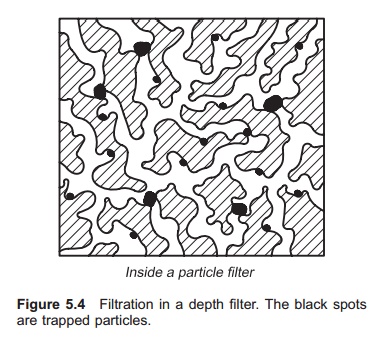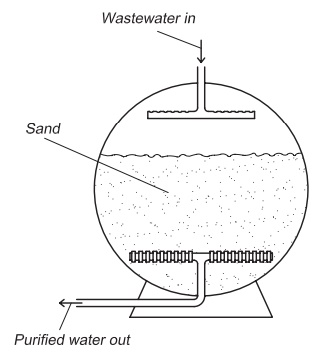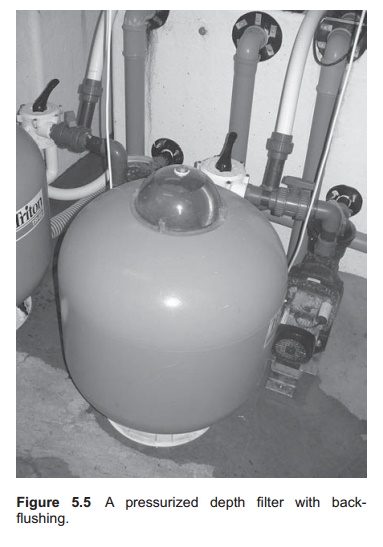Chapter: Aquaculture Engineering : Removal of Particles
Depth filtration granular medium filters - Methods for particle removal in fish farming
Depth filtration -
granular medium filters
Depth filtration, also called sand filtration, or just
filtration, means removal of particles when water is forced to flow through a
layer of a material with particles (granular filter medium) of various sizes
and depths, this filtration layer can be of sand or another granular material,
depending on the purpose for which the filter is to be used. Because sand is a
commonly used the filter is often called a sand filter. The layer is not dense
but contains a number of channels and holes created between the particles that
constitute the filter medium (Fig. 5.4).
When the water that contains particles goes through the filter
medium, particles larger than a certain size will be trapped by several
mecha-nisms. They may be too large to go through chan-nels
(straining); they may settle both unaltered and

The first process will occur on the top layer of the filter
medium; particles are trapped because they are too large to pass into the
channels or pores in the filter media, which will then become blocked. It is,
however, of some concern that a few large parti-cles block surface channels of
the medium causing a large reduction in filter capacity. The head loss
increases and the filter becomes blocked more quickly. Therefore it is more
important to utilize settling, adsorption and other effects inside the filter
medium; the total depth of the filter medium is then utilized, not just the top
layer. However, this requires a low water velocity through the filter medium,
which again means that the hydraulic load on the filter surface must be low.
When the chan-nels inside the filter are full of particles the head loss will
increase.
The maximum particle size that will pass through a depth filter
is determined by the grain size of the medium; if the grain size is small, the
filter will clog easily. The flow rate through filter medium and the rate of
clogging depend not only on the grain size of the filter medium, but also on
the characteristics of the particulates in the water to be purified. The
performance of a depth filter is dependent both on the type of filter and
operating procedures, and also significantly on the characteristics of the
filter material.
Depth filters can be classified depending on the direction of
the water flow through the filter medium. In an up-flowing filter, the water
flows up through the filter medium, while in a down-flowing filter the water
flows downwards; the latter type is the most common. Good filtration can be
achieved, but the filter medium becomes clogged after a period. In an
up-flowing filter the same will occur; here there may also be a break-through
of waste-water at one or several places in the filter medium if there is
excessive clogging, provided that the water pressure is high enough. In this
case almost all the water will go through the filter via these zones and there
will be virtually no purification.
A depth filter should be equipped with back-flushing facilities,
or regular manual purification of the filter medium will be necessary. In a
traditional sand filtration system (on-site system, see later) used for
purification of municipal wastewater, this can be the case. Such systems can be
used for months or even years without doing anything because the wastewater is
only discharged onto the soil surface. Of course, this depends on the hydraulic
load on the surface area and the concen-tration of particles in the water.
If a filter is to maintain capacity, back-flushing is necessary.
Even when this is carried out, the hydraulic capacity of this filter type is
lower than that of, for instance, rotating microsieves. While doing the
back-flushing operation, the filter must be stopped; water is then sent the
opposite way through the filter media, so removing particles that have settled.
This back-flushing water is sent directly to the farm outlet. Most of the
running problems with depth filters are the result of improper back-flushing.
To achieve proper purifica-tion of the filter medium it is important that the
back-flushing water suspends trapped particles. Typical amounts of
back-flushing water are in the range 1–5% of the bulk flow.
Depth filters can be separated into those operat-ing at normal
atmospheric pressure or those having an over pressure inside the filter, i.e.
pressurized filters (Fig. 5.5). In a pressurized filter the medium may be put
inside a sealed chamber, with the same overflow arrangements as for an
unpressurized filter. When a pressurized filter starts to clog, the pressure
will increase and the particles will be pushed further down in the filter
medium;


ultimately such a filter will become totally blocked, but it takes
longer than with an unpressurized filter. The advantages with pressurized
filters are that a larger part of the filter medium height is utilized and the
back-flushing interval is increased. To use a pres-surized filter it is
necessary to pressurize the water to be purified, normally up to 6–8 bar.
Usually the water passes through a pressure increase pump to achieve this, and
consideration must be given to avoiding damage to the particles. If such an
arrangement is used on the outlet water, the pump will break the particles up
and the proportion of small particles which are more difficult to remove will
increase. Therefore pressurized filters are not recommended for use on outlet
water; however, if there is no alternative the outlet water must be handled as
carefully as possible.
The normal filter medium is sand or gravel. The size of the sand
or gravel particles in the filter medium depends on the characteristics of the
par-ticles in the water to be purified. By using small par-ticles in the medium
the head losses and clogging velocity of the filter are increased whilst the
capacity is decreased. In a one size sand filter most of the filtration occurs
in the first few centimetres. Instead of using one type of medium over the
whole filter depth, i.e. a single size medium, media of several sizes
(multimedia) may be used to increase utilization of the filter. In such
filters, provided the water enters from the top of the filter and flows down,
the largest media are on the top and the smallest on the bottom. The largest
particles are then removed in the top layer and increasingly small particles
are removed through the lower layers of the filter. This will ensure a more
even col-lection of particles distributed over a larger part of the filter and
not just in the top layer. To avoid mixing of the media during back-flushing,
media with different relative density can be used. The largest media must have
the lowest density and the smallest the highest. When back-flushing from below
this will ensure that the largest particles stay on the top. In aquaria, a
two-media filter compris-ing a layer of crushed anthracite or ilmenite above a
layer of fine sand has been used. A third bottom layer with even finer
particles, such as crushed ilmenite or garnet, could also be included.
Regard-less of the filter media, it is of great importance that the
back-flushing is done correctly so that all the media are back-flushed,
otherwise there will be zones that are still clogged and that will not be
uti-lized when the filter is returned to operation.
Each medium can be characterized by its grain size, uniformity
of grain size, grain shape and rela-tive density, all factors that are
important for filter-ing performance. Appropriate grain parameters can
considerably reduce the resultant head losses.
Several classifications can be used on granular media filters,
and these can also be classified with respect to their hydraulic capacity
giving (1) slow sand filters, (2) rapid sand filters, and (3) continu-ously
back-flushed filters.21 Type 1 is unpressurized and type 2 is
pressurized; type 3 is constructed to enable continuous back-flushing without
interrupt-ing the water flow as is necessary for back-flushing types 1 and 2.
Typical reported loading rates are 0.68 l/s/m2 or less for slow sand
filters, up to 1.4 l/s/m2 for rapid sand filters and up to 5.4 l/s/m2
for contin-uously back-flushing sand filters.
In slow sand filters 2–5 mm grains are utilized;10
pressurized rapid single sand filters have grain sizes ranging from 0.3 to 4
mm.22 Reported removal rates are for 0.3 mm sand about 95% of
particles down to 6 μm, and for 0.5 mm sand about 95% of parti-cles down to 15 μm. A typical
pressurized rapid sand filter has a capacity of 136 kg sand, a surface area of
0.29 m2, a maximum pressure of 3.5 kg/cm2 and a design
flow rate of 238 l/min.
Depth filters can also be of the cartridge type. The cartridge
can be made of different materials, such as plastic, ceramic, spun fibre or
resinbound fibre, often specific to the supplier. The cartridge has a defined
depth, and the waste is collected either inside or outside the cartridge, or
has to pass through the cartridge. The typical cartridge filter is used once
and then replaced. Cartridge filters can be used for removal of small particles
and are avail-able for sizes below 1 μm. They are used on small water flows
with low particle loads; otherwise the cost of operation becomes too high.
Diatomite (DE) or pre-coated filters may also be classified as
depth filters.23 Diatomaceous earth filters comprise a filter with a
screen coated with DE (fuller’s earth), a granular material of fossil diatoms.
A cake of DE is formed and put on the filter screen that functions as a
skeleton. The water to be purified has to pass through this filter cake and the
particles are trapped. When the filter isdirty it can be back-flushed, or a new
filter cake can be installed. DE filters can tolerate higher water flows than
cartridge filters, but are best suited to small water flows.
Filter bags are another simple type of filter for use with small
water flows. The filter bag is woven and so forms a surface, the mesh size of
which depends on the closeness of the weave. Particles are trapped on the
surface of the bag. When no more water will pass through, the filter bag has to
be removed and replaced with a new or clean bag. The bags can be cleaned in a
washing machine, for instance.
Related Topics